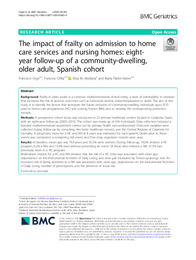Por favor, use este identificador para citar o enlazar este ítem:
https://hdl.handle.net/11000/30506Registro completo de metadatos
| Campo DC | Valor | Lengua/Idioma |
|---|---|---|
| dc.contributor.author | Cegri Lombardo, Francisco | - |
| dc.contributor.author | Orfila, Francesc | - |
| dc.contributor.author | Abellana, Rosa | - |
| dc.contributor.author | Pastor-Valero, Maria | - |
| dc.contributor.other | Departamentos de la UMH::Salud Pública, Historia de la Ciencia y Ginecología | es_ES |
| dc.date.accessioned | 2024-01-12T08:14:50Z | - |
| dc.date.available | 2024-01-12T08:14:50Z | - |
| dc.date.created | 2020-08 | - |
| dc.identifier.citation | BMC Geriatrics, Article number: 281 (2020) | es_ES |
| dc.identifier.issn | 1471-2318 | - |
| dc.identifier.uri | https://hdl.handle.net/11000/30506 | - |
| dc.description.abstract | Background: Frailty in older adults is a common multidimensional clinical entity, a state of vulnerability to stressors that increases the risk of adverse outcomes such as functional decline, institutionalization or death. The aim of this study is to identify the factors that anticipate the future inclusion of community-dwelling individuals aged ≥70 years in home care programmes (HC) and nursing homes (NH), and to develop the corresponding prediction models. Methods: A prospective cohort study was conducted in 23 primary healthcare centers located in Catalonia, Spain, with an eight-year follow-up (2005–2013). The cohort was made up of 616 individuals. Data collection included a baseline multidimensional assessment carried out by primary health care professionals. Outcome variables were collected during follow-up by consulting electronic healthcare records, and the Central Registry of Catalonia for mortality. A prognostic index for a HC and NH at 8 years was estimated for each patient. Death prior to these events was considered a competing risk event, and Fine–Gray regression models were used. Results: At baseline, mean age was 76.4 years and 55.5% were women. During follow-up, 19.2% entered a HC program, 8.2% a NH, and 15.4% died without presenting an event. Of those who entered a NH, 31.5% had previously been in a HC program. Multivariate models for a HC and NH showed that the risk of a HC entry was associated with older age, dependence on the Instrumental Activities of Daily Living, and slow gait measured by Timed-up-and-go test. An increased risk of being admitted to a NH was associated with older age, dependence on the Instrumental Activities of Daily Living, number of prescriptions, and the presence of social risk. | es_ES |
| dc.format | application/pdf | es_ES |
| dc.format.extent | 13 | es_ES |
| dc.language.iso | eng | es_ES |
| dc.publisher | BMC | es_ES |
| dc.rights | info:eu-repo/semantics/openAccess | es_ES |
| dc.rights.uri | http://creativecommons.org/licenses/by-nc-nd/4.0/ | * |
| dc.subject | Cohort study | es_ES |
| dc.subject | Frail elderly | es_ES |
| dc.subject | Primary health care | es_ES |
| dc.subject | Risk prediction models | es_ES |
| dc.subject | Long-term home care | es_ES |
| dc.subject | Long-term institutionalcare | - |
| dc.subject.other | CDU::6 - Ciencias aplicadas::61 - Medicina | es_ES |
| dc.title | The impact of frailty on admission to home care services and nursing homes: eightyear follow-up of a community-dwelling, older adult, Spanish cohort | es_ES |
| dc.type | info:eu-repo/semantics/article | es_ES |
| dc.relation.publisherversion | https://doi.org/10.1186/s12877-020-01683-9 | es_ES |

Ver/Abrir:
2-12877_2020_Article_1683.pdf
1,07 MB
Adobe PDF
Compartir:
 La licencia se describe como: Atribución-NonComercial-NoDerivada 4.0 Internacional.
La licencia se describe como: Atribución-NonComercial-NoDerivada 4.0 Internacional.
.png)